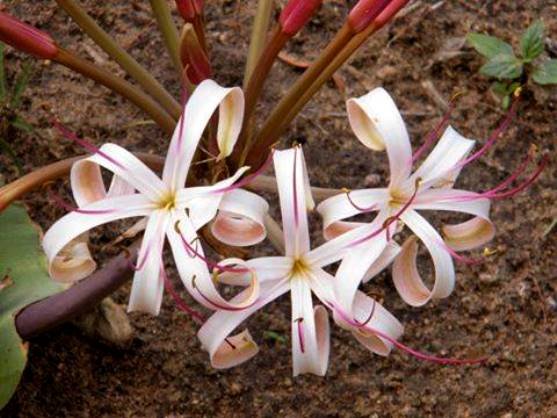Crinum buphanoides

Author: Ivan Lätti
Photographer: Piet Grobler
Crinum buphanoides, previously C. leucophyllum, is a deciduous, bulbous geophyte from 35 cm to 50 cm in height when flowering. The long-lived, globose bulb is about 15 cm in diameter, covered in several layers of membranous, brown outer tunic extending into a neck up to 12 cm long.
The twelve to sixteen strap-shaped and channelled leaves alternate, sheathing each other at the base distichously to form a pseudostem of up to 30 cm. Leaf colour is pale green to blue-green, the margins with fine cartilaginous teeth sometimes undulating. Leaf dimensions are from 30 cm to 50 cm long and from 12 cm to 15 cm wide.
The inflorescence is a large umbel on a long, curving or recumbent and flattened peduncle up to 45 cm long, bearing from 13 to 50 sweetly fragrant flowers. Two broadly lance-shaped spathe bracts that initially covered the buds, are present at the top of the peduncle. The almost radially symmetrical perianths face upwards, the tubes up to 10 cm long. The white or pale pink tepals are narrow, strap-shaped and arched back strongly, their keels white or pink.
The long, well exserted and spreading stamens have filaments that are white at the base, purplish higher up; some plants have one-coloured, white filaments. The style is also exserted and about erect, the stigma small. Flowering happens from late spring to summer.
A globose capsule follows, 2,5 cm long, with a short, curving beak. The pale green seeds are globose.
The species is distributed in Limpopo, Mpumalanga and northern Gauteng, more widely in southern Africa.
The habitat is semi-arid, open flats or lightly wooded terrain in deep, sandy or stony soils, as well as riverbeds and -banks. The plants grow solitary or in groups of varying size, leaves appearing first with summer rain, the plant dormant in winter. The habitat population is deemed of least concern early in the twenty first century (Duncan, et al, 2016; Onderstall; 1996; iNaturalist; http://redlist.sanbi.org).

